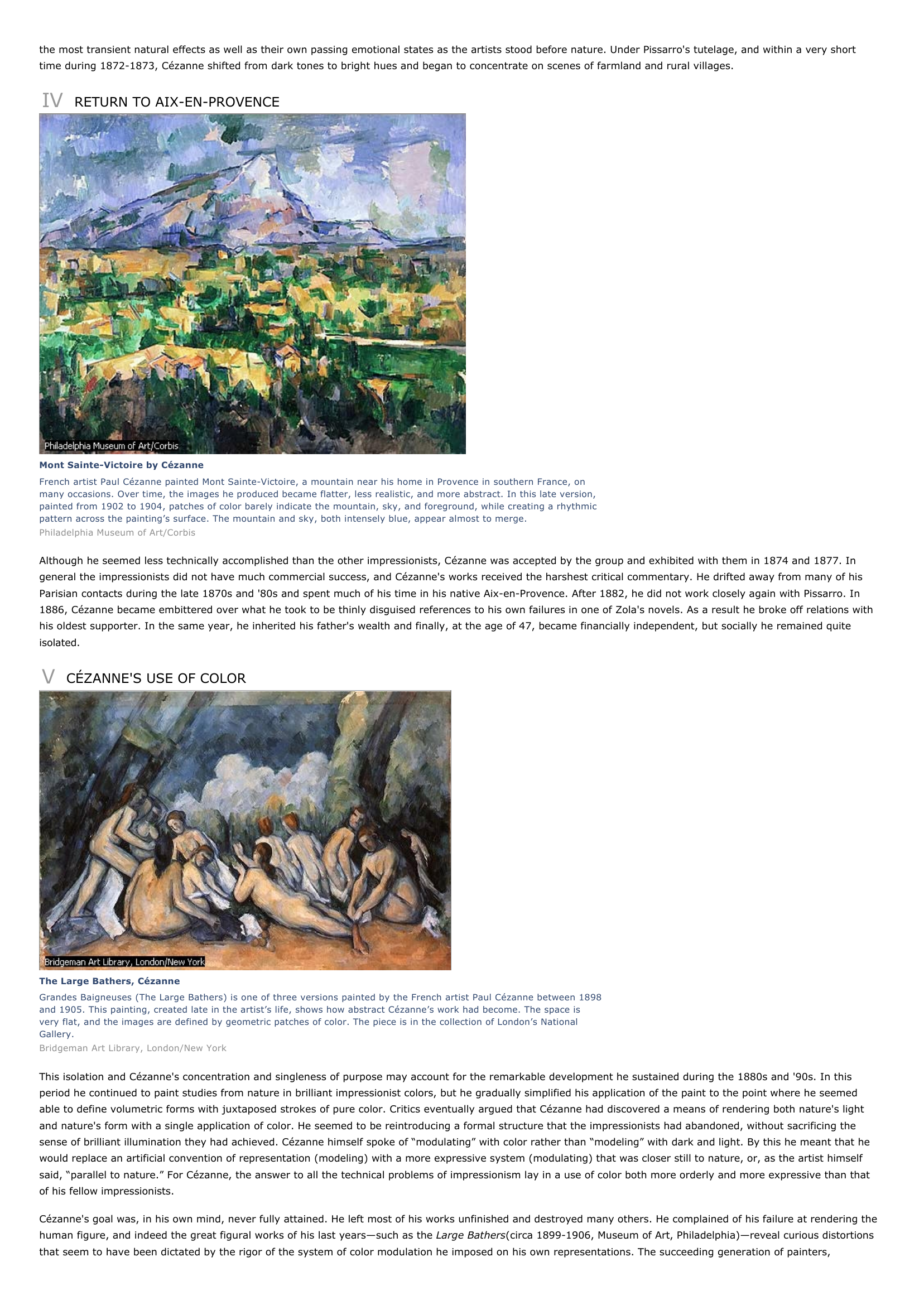Paul Cézanne I INTRODUCTION Peaches and Pears Peaches and Pears (1888) by Paul Cézanne displays a sense of unity and continuity typical of the artist's many still-life paintings.
Publié le 12/05/2013

Extrait du document
«
the most transient natural effects as well as their own passing emotional states as the artists stood before nature.
Under Pissarro's tutelage, and within a very shorttime during 1872-1873, Cézanne shifted from dark tones to bright hues and began to concentrate on scenes of farmland and rural villages.
IV RETURN TO AIX-EN-PROVENCE
Mont Sainte-Victoire by CézanneFrench artist Paul Cézanne painted Mont Sainte-Victoire, a mountain near his home in Provence in southern France, onmany occasions.
Over time, the images he produced became flatter, less realistic, and more abstract.
In this late version,painted from 1902 to 1904, patches of color barely indicate the mountain, sky, and foreground, while creating a rhythmicpattern across the painting’s surface.
The mountain and sky, both intensely blue, appear almost to merge.Philadelphia Museum of Art/Corbis
Although he seemed less technically accomplished than the other impressionists, Cézanne was accepted by the group and exhibited with them in 1874 and 1877.
Ingeneral the impressionists did not have much commercial success, and Cézanne's works received the harshest critical commentary.
He drifted away from many of hisParisian contacts during the late 1870s and '80s and spent much of his time in his native Aix-en-Provence.
After 1882, he did not work closely again with Pissarro.
In1886, Cézanne became embittered over what he took to be thinly disguised references to his own failures in one of Zola's novels.
As a result he broke off relations withhis oldest supporter.
In the same year, he inherited his father's wealth and finally, at the age of 47, became financially independent, but socially he remained quiteisolated.
V CÉZANNE'S USE OF COLOR
The Large Bathers, CézanneGrandes Baigneuses (The Large Bathers) is one of three versions painted by the French artist Paul Cézanne between 1898and 1905.
This painting, created late in the artist’s life, shows how abstract Cézanne’s work had become.
The space isvery flat, and the images are defined by geometric patches of color.
The piece is in the collection of London’s NationalGallery.Bridgeman Art Library, London/New York
This isolation and Cézanne's concentration and singleness of purpose may account for the remarkable development he sustained during the 1880s and '90s.
In thisperiod he continued to paint studies from nature in brilliant impressionist colors, but he gradually simplified his application of the paint to the point where he seemedable to define volumetric forms with juxtaposed strokes of pure color.
Critics eventually argued that Cézanne had discovered a means of rendering both nature's lightand nature's form with a single application of color.
He seemed to be reintroducing a formal structure that the impressionists had abandoned, without sacrificing thesense of brilliant illumination they had achieved.
Cézanne himself spoke of “modulating” with color rather than “modeling” with dark and light.
By this he meant that hewould replace an artificial convention of representation (modeling) with a more expressive system (modulating) that was closer still to nature, or, as the artist himselfsaid, “parallel to nature.” For Cézanne, the answer to all the technical problems of impressionism lay in a use of color both more orderly and more expressive than thatof his fellow impressionists.
Cézanne's goal was, in his own mind, never fully attained.
He left most of his works unfinished and destroyed many others.
He complained of his failure at rendering thehuman figure, and indeed the great figural works of his last years—such as the Large Bathers (circa 1899-1906, Museum of Art, Philadelphia)—reveal curious distortions that seem to have been dictated by the rigor of the system of color modulation he imposed on his own representations.
The succeeding generation of painters,.
»
↓↓↓ APERÇU DU DOCUMENT ↓↓↓
Liens utiles
- Poseidon Greek Sea god and one of the Olympian gods; son of Cronus and Rhea; brother of Zeus, Hades, Demeter, Hera, and Hestia; husband The Roman goddess Pomona displays her fruits of plenty in the painting by French artist Nicholas Fouche (1653-1733).
- Earth Mother A symbol in many ancient myth systems of the Earth, the source of all life and the power to create life.
- Vincent van Gogh I INTRODUCTION Church at Auvers by Van Gogh Dutch artist Vincent van Gogh spent the last months of his life in Auvers-sur-Oise, near Paris, under the care of Dr.
- Diego Velázquez (artist) I INTRODUCTION Velázquez and Baroque Theatricality Spanish painter Diego Velázquez presents two scenes in The Fable of Arachne (about 1656, Museo del Prado, Madrid, Spain), also known as The Spinners.
- Arthurian Legend I INTRODUCTION King Arthur Legend and lore surround the life of Arthur, a medieval king of the Britons.
















